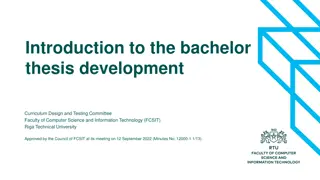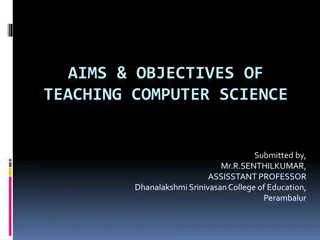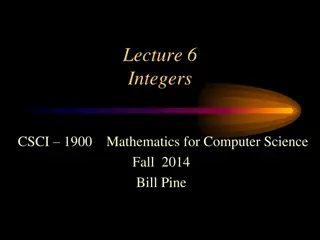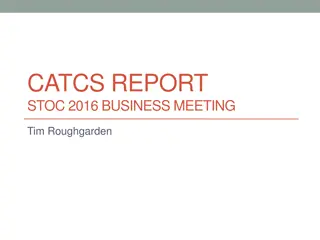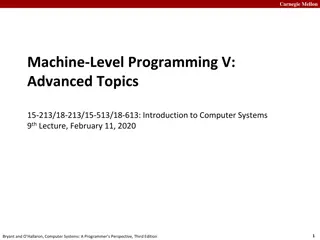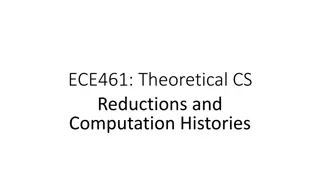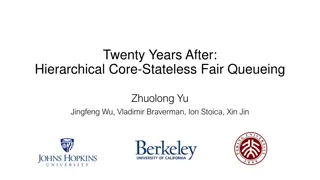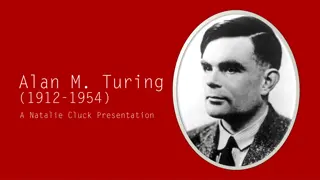Understanding Fair Allocation in Theoretical Computer Science
Explore the concepts of fair allocation through algorithms and protocols in the realm of theoretical computer science. Delve into topics such as resource allocation, cake cutting problems, envy-free protocols, and more, with a focus on maximizing social welfare, fairness, and stability. Gain insights into the strategies and theorems that ensure fair distribution among individuals.
Download Presentation

Please find below an Image/Link to download the presentation.
The content on the website is provided AS IS for your information and personal use only. It may not be sold, licensed, or shared on other websites without obtaining consent from the author. Download presentation by click this link. If you encounter any issues during the download, it is possible that the publisher has removed the file from their server.
E N D
Presentation Transcript
CMSC5706 Topics in Theoretical Computer Science Week Algorithms for fair allocation Algorithms for fair allocation Instructor: Shengyu Zhang 1
Resource allocation General goals: Maximize social welfare. Fairness. Stability. 2
Cake cutting Problem setting: One cake, ? people (who want to split it). Each person might value different portions of the cake differently. Some like strawberries, some like chocolate, Normalization: Each one values the whole cake as 1. This valuation info is private. Goal: divide the cake to make all people happy. 3
Cake cutting A cake cutting protocol is fair if each person gets 1/? fraction by her measure. No matter how other people behave. A cake cutting protocol is envy-free if each person thinks that she gets the most by her measure. Envy-free fair: ???: how much person ? gets in person ? s measure. Envy-free: ??? ???, ? fair:??? 1/?, ?. 4
? = 2 1. Alice cuts the cake into two equal pieces by her measure 2. Bob chooses a larger piece by his measure 3. Alice takes the other piece 5
envy-free Theorem. The outcome is envy-free (and thus fair). Proof. Alice: gets exactly half, no matter which piece Bob chooses. Bob: gets at least half, no matter how Alice cuts the cake. 7
? = 3 Stage 0: Player 1 divides into three equal pieces according to his valuation. Player 2 trims the largest piece s.t. the remaining is the same as the second largest. The trimmed part is called Cake 2; the other form Cake 1. 8
Stage 1: division of Cake 1 Player 3 chooses the largest piece. If player 3 didn t choose the trimmed piece, player 2 chooses it. Otherwise, player 2 chooses one of the two remaining pieces. Either player 2 or player 3 receives the trimmed piece; call that player ? and the other player by ? . Player 1 chooses the remaining (untrimmed) piece 9
Stage 2 (division of Cake 2) ? divides Cake 2 into three equal pieces according to his valuation. Players ?, 1, and ? choose the pieces of Cake 2, in that order. 10
Whole process ?? cuts cake 2 ?? ?1 ?? choose cake 2 ?3 ?2 ?1 choose cake 1 (three cases) ?1 cuts ?2 trims Cake 2 ?2 ?2 ?3 ?? ?? ?? ?1 ?2 ?3 ?? ?? ?3 ?1 ?1 ?? 11
Envy-freeness The division of Cake 1 is envy-free: Player 3 chooses first so he doesn t envy others. Player 2 likes the trimmed piece and another piece equally, both better than the third piece. Player 2 is guaranteed to receive one of these two pieces, thus doesn t envy others. Player 1 is indifferent judging the two untrimmed pieces and indeed receives an untrimmed piece. 12
Envy-freeness of Cake 2 Player ?goes first and hence does not envy the others. Player ? is indifferent weighing the three pieces of Cake 2, so he envies no one. Player 1 does not envy ? : Player 1 chooses before ? Player 1 doesn t envy ?: Even if T the whole Cake 2, it s just 1/3 according to Player 1 s valuation. 13
General ?? An algorithm using recursion. Suppose that the people are ?1, ,??. 1. Let ?1, ,?? 1 divide the cake. How? Recursively. 2. Now ?? comes. Each of ?1, ,?? 1 divides her share into ? equal pieces. ??takes a largest piece from each of ?1, ,?? 1. Let s try ? = 3 on board. 14
Fairness Theorem.The protocol is fair. Proof. ? 1 ? 1 1 1 ?. For ?1, ,?? 1: each gets = ? ??: gets ?1 ??: ?? s value of ?? s share in Step 1. Complexity? Let ? ? be the number of pieces. recursion: ? ? = ? ?(? 1) Try a few examples for small ? to convince yourself. ?(1) = 1, and ? ? = ?! for general ?. ?+ +?? 1 1 ? = ? 15
Moving Knife protocols Dubins-Spanier, 1961 Continuously move a knife from left to right. 1. A player yells out "STOP" as soon as knife has passed over 1/? of the cake by her measure. 2. The player that yelled out is assigned that piece. (And she is out of the game; ? ? 1.) break tie arbitrarily 3. The procedure continues until all get a piece. 16
Fairness and complexity Theorem.The protocol is fair. Proof. For the first who yells out: she gets 1/?. For the rest: each things that the remaining part has value at least ? 1 ?, and ? 1 people divide it. 1 ? 1 ? = ? 1 1 ?. Recursively: each gets Complexity? Only ? 1 cuts into ? pieces. 17
Resource allocation The previous example of cake cutting is to allocate divisible resource. Similar examples include time, memory on a computer, etc. But sometimes resources are indivisible. Pictures, cars, in heritage. Baby, house, in a divorce 18
Assignment 4 students just came to HK and they found an apartment with 4 rooms. Total rent for the apartment is ? They need to decide who lives in which room and pays how much 19
Assignment Note that each person has a different valuation of the four rooms. Someone prefers a large room with private bathroom. Someone prefers small room with low price. 20
General setup ??? ? people ? items ???: person ? s valuation of item ? ?? Solution: ?, ?? ? is a matching assigning item ?(?) to person ? ?? is the price for item ? 21
General setup ??? Solution: ?, ?? ? is a matching assigning item ?(?) to person ? ?? is the price for item ? Person ? s utility: ??= ??? ?? where ? = ?(?). ?? 22
General setup ??? Person ? s utility: ??= ??? ?? where ? = ?(?). The solution is envy- free if ?? ??? ?? , ? Everyone is happy and secretly thinks that all others are dumb ass! ?? 23
General setup ??? Question 1: Does there exist an envy-free solution? Sounds too good to be true. Question 2: If there exists envy-free solutions, can we find one efficiently? Seems pretty hard ?? 24
General setup ??? Question 1: Does there exist an envy-free solution? Yes! Question 2: If there exists envy-free solutions, can we find one efficiently? Yes! ?? 25
General setup ??? Question 1: Does there exist an envy- free solution? Yes! Question 2: If there exists envy-free solutions, can we find one efficiently? Yes! ?? That s the power of linear program! 26
Item owners utility Recall: If person ? is assigned item ?, then person ? s utility is ??= ??? ??. We can also think of item ? has a utility of ?? Item owner gets this money. Thus overall the pair (?,?) of agents get utility ??+ ??= ???. Social welfare: total utility of all agents. ????, where ? = ?(?). 27
LP Though the apartment is indivisible, let s treat it as divisible for the moment. Let ??? be the fraction of apartment ? taken by person ?. ???? 1: each person takes at most 1 apartment. ???? 1: the fractions sum up to 1. ??? 0. 28
LP Consider the following LP, which maximize the social welfare. max ???????? s.t. ???? 1, ? ???? 1, ? ??? 0, ?,? Issue: If the optimal solution ? to this LP is fractional, how to assign the indivisible items? 29
Surprise Good news: It s not really an issue! Theorem. The feasible region of the above LP is the convex hull of integral solutions ?, where each ??? 0,1 . In particular, there exists an optimal 0,1 - solution. Next we show how to find it efficiently using duality. 30
Primal max ??? s.t. ?? ? Dual min ??? s.t. ??? ? ? 0 ? 0 31
Primal max ??? s.t. ?? ? Dual min s.t. ??? ??? ? ? 0 ? 0 max ???????? s.t. ???? 1, ? ???? 1, ? ??? 0, ?,? min ???+ ??? s.t. ??+ ?? ???, ?,? ?? 0, ? ?? 0, ? 1 0 0 1 0 0 1 0 0 0 1 0 0 1 0 0 1 0 0 0 1 0 0 1 0 0 1 1 0 0 0 1 0 0 0 1 1 0 0 0 1 0 0 0 1 1 0 0 0 1 0 0 0 1 1 1 1 0 0 0 0 0 0 1 0 0 0 1 0 0 0 1 0 0 0 1 1 1 0 0 0 1 0 0 0 1 0 0 0 1 0 0 0 0 0 0 1 1 1 1 0 0 0 1 0 0 0 1 ??= ? = 32
dual Primal Dual max ???????? s.t. ???? 1, ? ???? 1, ? ??? 0, ?,? min ???+ ??? s.t. ??+ ?? ???, ?,? ?? 0, ? ?? 0, ? 33
Dual min ???+ ??? s.t. ??+ ?? ???, ?,? ?? 0, ? ?? 0, ? The condition has a meaning of envy-free: Suppose that ?? is utility, and ?? is price. If ??+ ??< ???, then person ? would like to take item ?. since he then has utility ??? ??> ??. 34
Complementary slackness Primal max ??? s.t. ?? ? Dual min s.t. ??? ??? ? ? 0 ? 0 Theorem. If ? and ? are optimal for Primal and Dual, respectively, then ?? ?? Proof. Note ? ? ??? ? = ? ?? ? ?. But by strong duality, ? ? = ? ? , thus equality holds. Thus if ?? If ?? > 0 ?? ? = ??, where ?? is the ?-th column of ? > 0 ?? ? = ??, where ?? is the ?-th row of ? > 0, the first (in)equality implies ?? ? = ??. > 0, the second (in)equality implies?? ? = ??. 35
algorithm Complementary slackness here: ???= 1 ??+ ??= ??? So to find an assignment, it is enough to solve the dual, collect edges ? = find a perfect matching ? in the graph ? = (?,?,?). define ???= 1 if and only if ?,? ? This ? is a {0,1} optimal solution to the primal. ????????= ?,? :???=1???= ?,? :???=1(??+ ??) = ???+ ??? The utility and price are also given by ?? and ??. Dual variables coincide with utility and price. ?,? :??+ ??= ??? 36
Summary Resource allocation naturally arises in many applications. Main goal is to achieve high social welfare as well as fairness. Examples: Divisible: cake cutting Indivisible: assignment game 37











